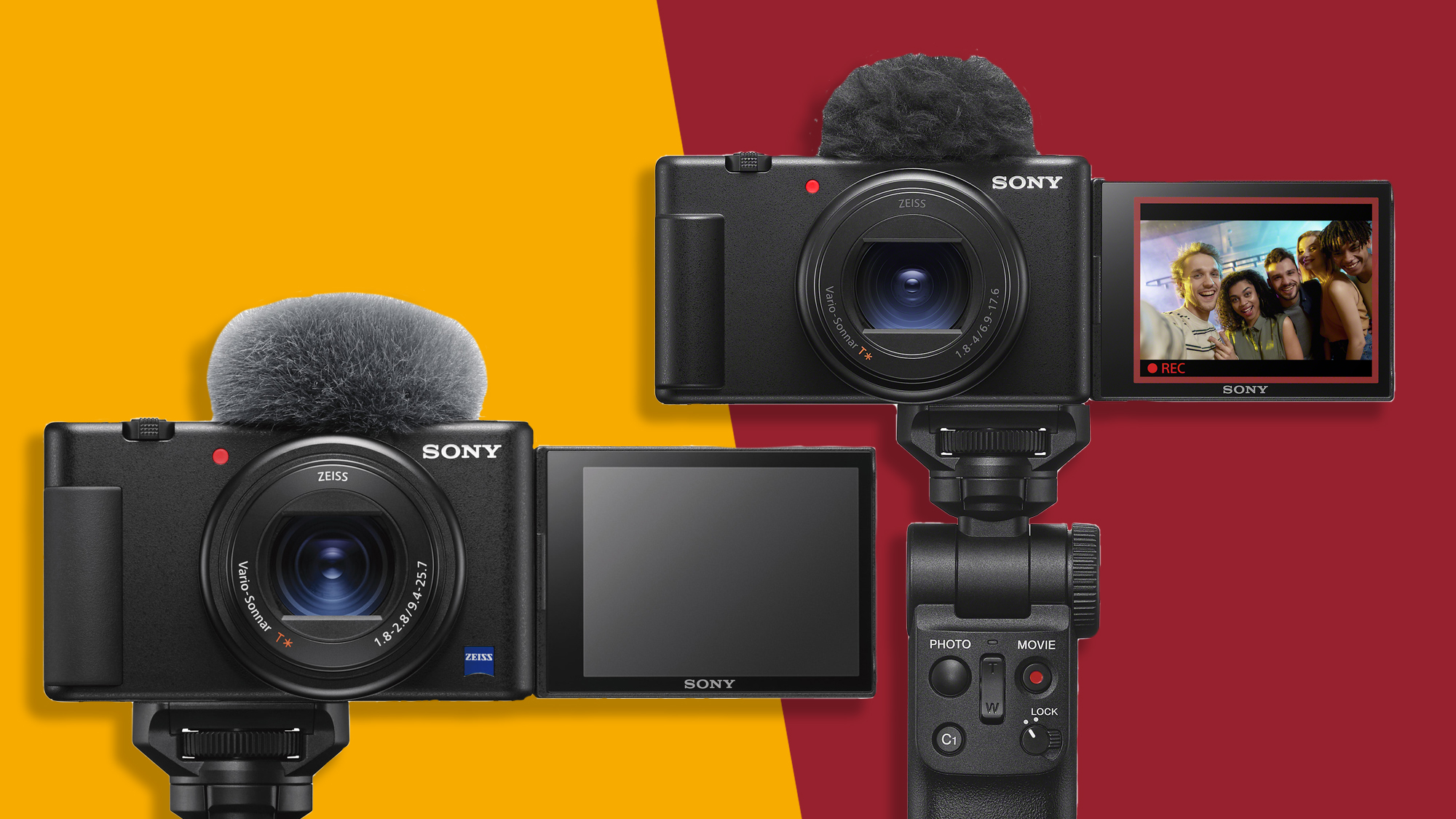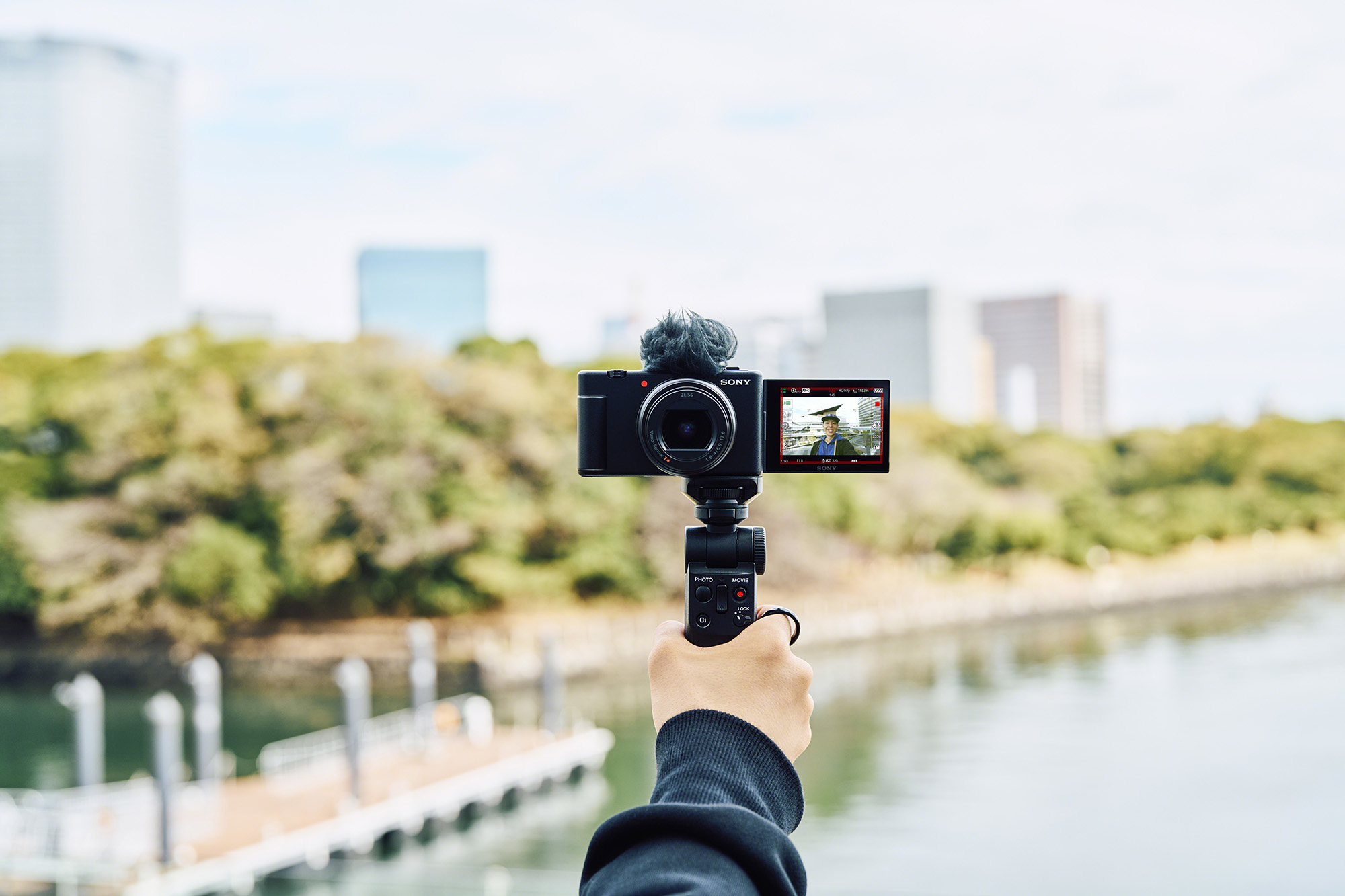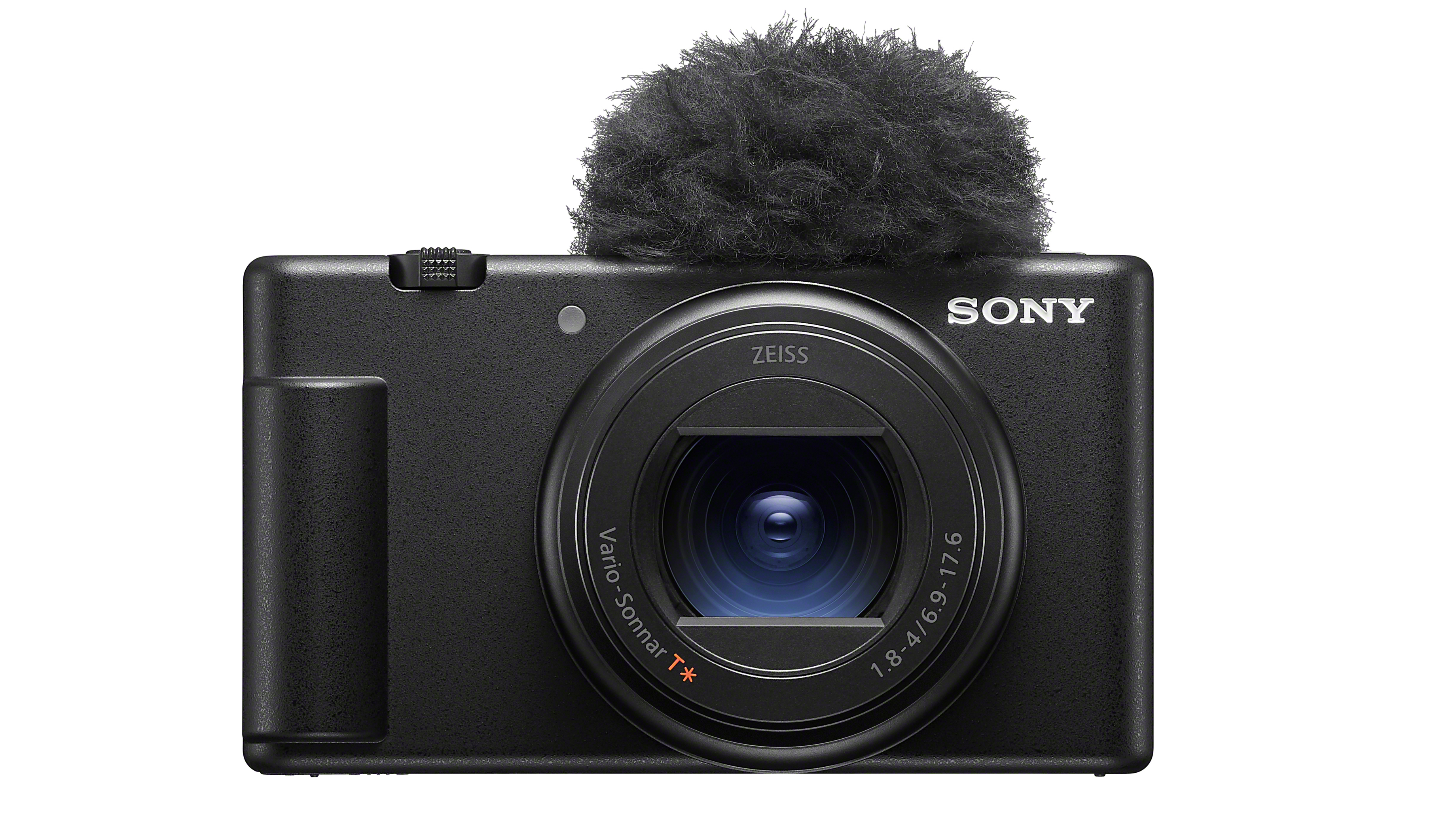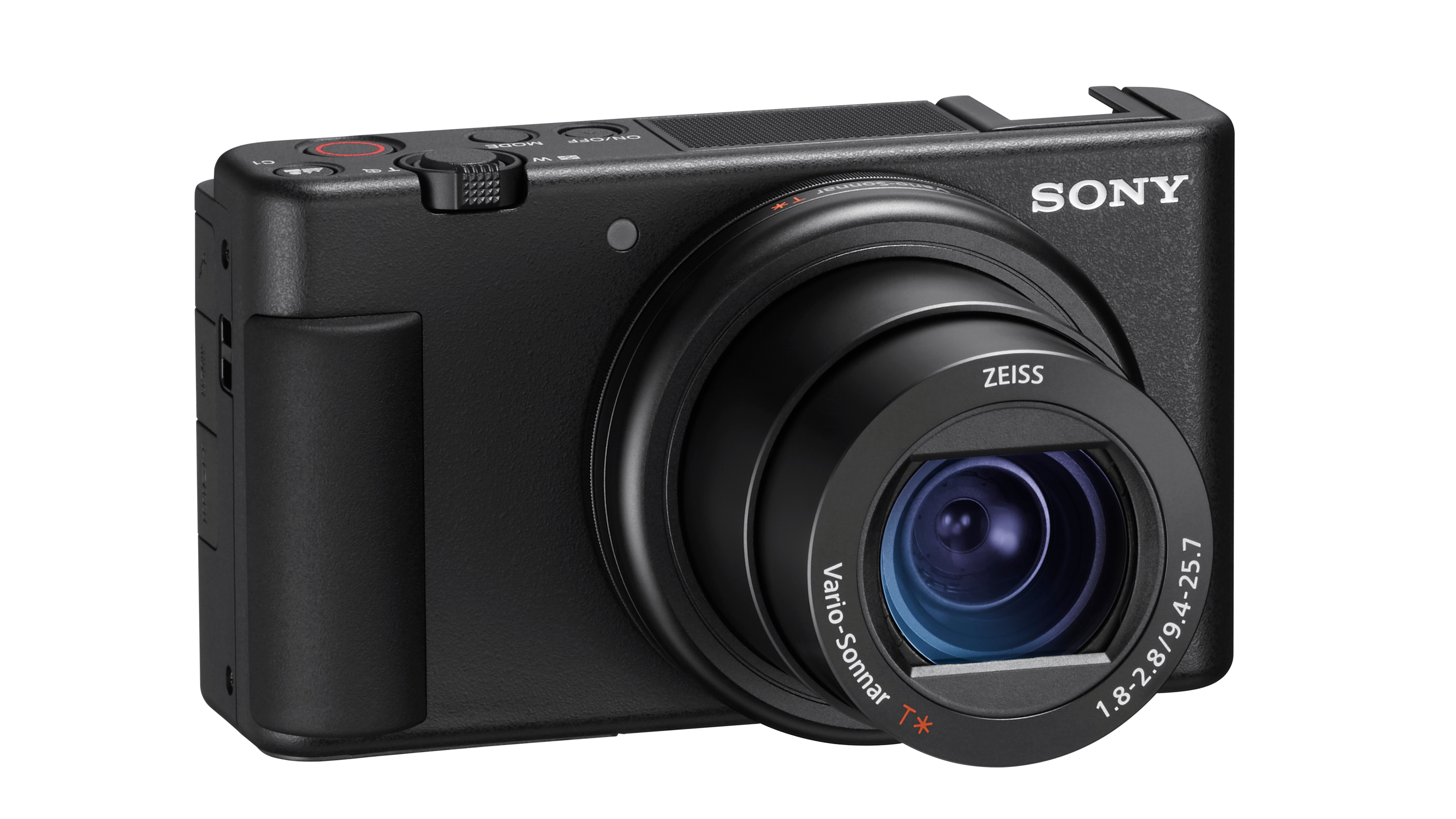
The electronic giant’s original compact vlogging camera from 2020 still holds much appeal
For
- Compact, portable and pocket sized
- Vari-angle display
- 24-70mm equivalent focal range
Against
- Image stabilization a let down for video when walking
- Micro USB rather than USB-C
- Touch screen offers limited functionality
Update to the original retains what made its predecessor popular and adds operational tweaks
For
- New ultra wide 18mm equivalent zoom lens
- Improved touch screen functionality
- New Cinematic Vlog & My Image Style picture settings
Against
- No headphone jack
- No USB-C cable or mains adapter supplied
- Sony’s ‘Active’ electronic stabilization only (same as the original ZV-1)
Tech manufacturers have long been excited about the prospect of pitching their new gear to the online influencer. Way before every manufacturer’s press release was telling us their new camera was aimed at the ‘content creator’, Sony had already identified the burgeoning market for ‘vlogging’.
Appearing mid lockdown in June 2020, its compact ZV-1 vloggers’ camera always felt like the first in a new wave of products, confirmed by the subsequent introduction of the Sony ZV-E10 in August 2021, ZV-1F starter model in October 2022, and ZV-E1 in April 2023.
Now three years on to the exact month of the original ZV-1’s release, we don’t get the obvious numerical progression of a ZV-2, but rather the introduction of a ZV-1 II, its Mark 2 suffix underlining a direct link back to the original.
With the main selling point of the ZV-1 on launch being its suitability for any content creator at any skill level, we’re taking a deep dive into its subsequent iteration here, asking what the second generation brings to the party that makes it demonstrably better? After all, our original TechRadar review of the Sony ZV-1 called it “the best compact vlogging camera you can buy”, so there is a fair amount to live up to.

Sony ZV-1 vs Sony ZV-1 II: Price and availability
- Sony ZV-1: $749 / £699 / AU$1,299
- Sony ZV-1 II: $899 / £870 / AU$1,499
The original list price of the Sony ZV-1 was $749 / £699 / AU$1,299
At the time of writing the updated Sony ZV-1 II, also landing June, has a higher launch price of $899 / £870/ AU$1,499, which is a little disappointing.
A bundle for the ZV-1 II is promised which includes Sony’s GP-VPT2BT wireless shooting grip, for both stability and comfort of use as well as wireless control over select shooting settings. While we don’t have a bundle price at the time of writing, the same Bluetooth grip controller offered alongside the ZV-1 on launch retailed for $138/ £170 / AU$249.
With the ZV-1 being the older model in this pairing, we’d anticipate deals to be had on the original for a limited time while stocks last – and if we’re prepared to shop around – while even if price on launch holds, it is still a less expensive option than the newer ZV-1 II.

Sony ZV-1 vs Sony ZV-1 II: Sensors
- Same 20.1MP 1-inch Exmor R CMOS sensor
- Neither has in-body stabilization
As its model name implied the Sony ZV-1 was not only the manufacturer’s first camera in a new line up of video first devices for vlogging; it also featured a one-inch CMOS sensor at its heart, married to Sony’s Bionz X processor. While this sensor was physically larger than the 1/2.3-inch chip featured in basic point-and-shoot cameras, it fell short of the larger APS-C and full frame sensors found in DSLRs and mirrorless cameras.
It wasn’t a great surprise then that the Sony ZV-E10 followed a year later, at very similar price to the original ZV-1, and traded this up for an APS-C sized chip, as featured in Sony’s existing Alpha series digital cameras. And yet the ZV-1F that followed on in its wake still featured a one inch, or 13.2x8.8mm, back-illuminated sensor, just like the original ZV-1.
Three years on, and the obvious question is which sensor do we find in the ZV-1 II?
Well, the short answer is Sony has taken the ‘if it ain’t broke, don’t fix it’ approach with the second iteration. Once again it incorporates a 20.1 megapixel, one-inch Exmor RS CMOS sensor and the same generation Bionz X processor as the original model. While that doesn’t lend us much ammunition for making comparisons, even a one-inch sensor is larger than those found in the average smartphone, so, when coupled with a larger lens, we can theoretically expect image quality to be better than the handset in our pocket.

Sony ZV-1 vs Sony ZV-1 II: Video
- Both offer 4K /30p
- ZV-1 II improved AF in video mode can now recognise animals, not just human faces
The original Sony ZV-1 offered video recording up to 4K in resolution at 30fps, with auto focus in movie mode able to automatically recognise human faces in the frame. The ‘new improved’ AF of the Sony ZV-1 II in movie mode is now able to recognise animals as well as human faces – which makes a lot of sense, given the popularity of both for online video postings. The new model however maintains resolution at 4K and a 30fps frame rate.
Of course a decent video performance is nothing without great sound to accompany it. The ZV-1 II’s built-in microphone y can capture audio to the rear, front or in all directions relative to the device, or, as the ZV-1 again provided, there is the opportunity to attach an external microphone for more professional sound. The Mark II is compatible with the ECM-G1 shotgun microphone specially devised for vloggers, but we’re told is not compatible with the ECM-B10 compact digital microphone. There is no headphone jack on the device, but a fluffy ‘dead cat’ windshield is bundled with the Sony ZV-1 II, as it was with the original model, for improved audio when recording in breezy conditions. This again slots into the camera’s hotshoe.
As expected, on the ZV-1 II we can live stream video and sound via USB connection to a computer or Sony Xperia smartphone. Via Bluetooth the device is also compatible with Sony’s Creator app and likewise its software can be updated via the app too.
Videographers should also note that, in terms of differentiation from the ZV-1, the new camera inherits a Cinematic Vlog setting from the ZV-E1 that fixes the frame rate at 24fps, while a ‘creative look’ color profile is carried over from the existing ZV-E10 – essentially mood enhancing image processing. In terms of stills, the ZV-1 II can record Raw files separately or in tandem with JPEGs, or of course we can opt for Fine quality JPEGS on their own.
It’s also worth adding that the bright f/1.8 maximum aperture setting provided by both iterations of the same camera allows for sharply focused subjects and attractively de-focused backgrounds – the so-called ‘bokeh’ effect. For group portraits a useful function the ZV-1 II inherits from the ZV-E1 is multi face recognition, which means that not one but all faces in the frame are in focus. Again we get a customizable button for ‘Bokeh Switch’, which will instantly switch to a wide-open aperture to give our footage a defocused background, along with Product Showcase auto focus which ensures that if we hold a product up to the camera it will bias focus towards that, rather than any faces in the frame. Aside from the main shutter release button we also get a dedicated record button and both cameras similarly share a built-in ND filter to keep transitions smooth in brighter conditions.

Sony ZV-1 vs Sony ZV-1 II: Build & weight
- Sony ZV-1 has a 24-70mm f/1.8-2.8 lens
- Sony ZV-1 II has a 18-50mm f/1.8-4 lens
Ideally we want any blogging camera designed for everyday use to be portable. The initial ZV-1 made the claim on its launch of being conveniently pocket sized, and the same can be said of the newer ZV-1 II.
Sensor aside, the other most important aspect of the original Sony ZV-1 was the premium Zeiss branded lens bolted on the front – providing an equivalent focal range of 24-70mm in 35mm terms. Its use is supported by Sony’s ‘Active’ image stabilization, which is electronic rather than mechanical, and uses an image crop to minimize any visible judder. Again on the ZV-1 II slightly disappointingly we get electronic rather than actual in-body sensor shift stabilization.
However, claimed to be in response to customer feedback, the Vario-Sonnar T* Zeiss lens on the new Sony ZV-1 II now, by contrast, starts out wider at 18mm equivalent, meaning it also finishes slightly shorter than its predecessor at 50mm. The aperture range for the zoom now runs from f/1.8-f/4, as opposed to its predecessors’ consistently brighter f/1.8-f/2.8. However, should we desire, a digital zoom lever allows the new model’s telephoto capability to be boosted to a 100mm equivalent without noticeable loss in image quality.
Taking its cue from the angle adjustable LCDs commonly featured on camcorders back in the day and most stills oriented digital cameras today, the Sony ZV-1 featured a side opening vari-angle LCD touchscreen. At the time this was a first for a Sony compact camera, in lieu of any eye-level electronic viewfinder provided. Still the lack of an EVF did provide room for a hotshoe. Again there is no EVF on the ZV-1 II, but there is again an analogue hotshoe.
We’re told customer feedback to the original ZV-1 suggested there were limits to the operability of its screen. In fact, Sony now describes the touchscreen on the ZV-1 as offering ‘basic’ touch operation – as we could tap the screen to pull focus when recording videos, but not navigate menus or even enlarge sections of photographs – whereas the touchscreen on the ZV-1 II by comparison is claimed to be ‘fully touch capable’. In this respect the operation of the ZV-1 II’s screen is closer to the existing ZV-1F.
Thus on the Sony ZV-1 II we get access to control settings via the touch screen, which is once again of the flip-out and twist vari-angle variety. A red frame is displayed surrounding the entire circumference of the screen when recording has started, to provide extra reassurance. Interestingly a screen reader function is also offered alongside the latest device that aids visually impaired content creators by reading out whatever is displayed on screen, with multiple languages already installed.
Size wise the newer ZV-1 II is a hair’s breadth bigger than the original ZV-1 at dimensions of 105.5x60x46.7mm, as opposed to the original’s 105.5x60x43.5mm, even if it is actually a smidgeon lighter at 292g, compared with the ZV-1’s 294g. We’d wager such differences are imperceptible when the devices are held in the hand however, so hardly something to base a purchase decision on. Ultimately the compact size of both makes them ideal for YouTube-rs who want to record their travel adventures, while the build is sturdy enough to reassure they’d withstand the odd accidental knock or being jogged about in a backpack.

Sony ZV-1 vs Sony ZV-1 II: Additional features
- Sony ZV-1: X-battery, 45 minutes of recording, micro USB connectivity
- Sony ZV-1 II: X-battery, 45 minutes of recording, USB-C connectivity
With no standalone mains charger provided out of the box, the Sony Z-V1 II’s lithium ion rechargeable battery is powered in situ via USB lead, with a USB-C connection provided this time around as opposed to its predecessor’s micro USB connection. Otherwise the second-generation camera features the exact same battery as the original ZV-1 and we’re told performance is the same too, with both batteries lasting for an adequate 45 minutes of recording time, or around 260 still images. By contrast the same battery in the ZV-1F lasts a full hour of usage.
Both original and second-generation cameras feature a single removable media card slot, each being conveniently compatible with the common SDXC/ SDHC cards. We’ll need to insert one before we can begin operation.

Which one should I buy?
You’d think a choice between the ZV-1 and the ZV-1 II would be a no-brainer and we’d automatically advise going for the newer model to ensure a degree of future proofing.
However, with the focal range of each being slightly different, in terms of visual framing and composition, the choice is not quite so clear-cut – even if the sensor and image processor at their heart remains the same. That said, it always comes down to budget, and the older model’s launch price being decisively less expensive than Sony’s newcomer might tip it in our favor if money is tight.
Features wise and operationally, ultimately it doesn’t appear like the ZV-1 II is a massive step on from the ZV-1. Adjustment to the zoom range aside, it’s more a case of subtle operational tweaks and refinements, including a more responsive touch screen. Even three years on, Sony obviously feels there’s a lot about its original vlog camera still to like. Perhaps that’s why it decided to simply add a Mark II to the model name, to suggest a continuation of excellence, rather than a wholly new device.







